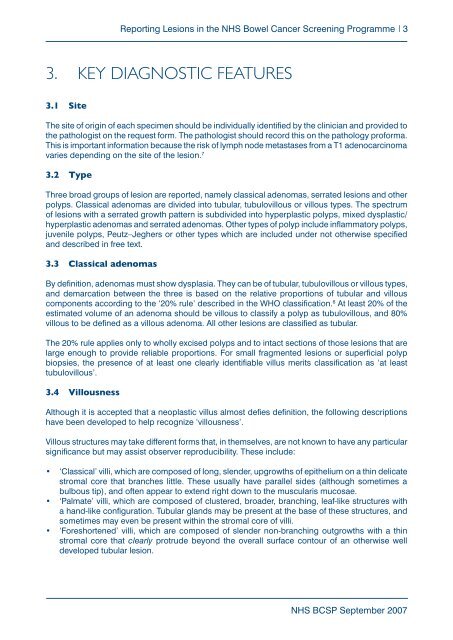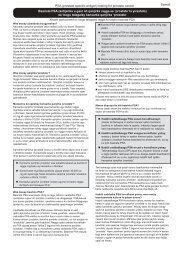reporting lesions in the nhs bowel cancer screening programme
reporting lesions in the nhs bowel cancer screening programme
reporting lesions in the nhs bowel cancer screening programme
You also want an ePaper? Increase the reach of your titles
YUMPU automatically turns print PDFs into web optimized ePapers that Google loves.
Report<strong>in</strong>g Lesions <strong>in</strong> <strong>the</strong> NHS Bowel Cancer Screen<strong>in</strong>g Programme | 3<br />
3. KEY DIAGNOSTIC FEATURES<br />
3.1 Site<br />
The site of orig<strong>in</strong> of each specimen should be <strong>in</strong>dividually identified by <strong>the</strong> cl<strong>in</strong>ician and provided to<br />
<strong>the</strong> pathologist on <strong>the</strong> request form. The pathologist should record this on <strong>the</strong> pathology proforma.<br />
This is important <strong>in</strong>formation because <strong>the</strong> risk of lymph node metastases from a T1 adenocarc<strong>in</strong>oma<br />
varies depend<strong>in</strong>g on <strong>the</strong> site of <strong>the</strong> lesion. 7<br />
3.2 Type<br />
Three broad groups of lesion are reported, namely classical adenomas, serrated <strong>lesions</strong> and o<strong>the</strong>r<br />
polyps. Classical adenomas are divided <strong>in</strong>to tubular, tubulovillous or villous types. The spectrum<br />
of <strong>lesions</strong> with a serrated growth pattern is subdivided <strong>in</strong>to hyperplastic polyps, mixed dysplastic/<br />
hyperplastic adenomas and serrated adenomas. O<strong>the</strong>r types of polyp <strong>in</strong>clude <strong>in</strong>flammatory polyps,<br />
juvenile polyps, Peutz–Jeghers or o<strong>the</strong>r types which are <strong>in</strong>cluded under not o<strong>the</strong>rwise specified<br />
and described <strong>in</strong> free text.<br />
3.3 Classical adenomas<br />
By def<strong>in</strong>ition, adenomas must show dysplasia. They can be of tubular, tubulovillous or villous types,<br />
and demarcation between <strong>the</strong> three is based on <strong>the</strong> relative proportions of tubular and villous<br />
components accord<strong>in</strong>g to <strong>the</strong> ‘20% rule’ described <strong>in</strong> <strong>the</strong> WHO classification. 8 At least 20% of <strong>the</strong><br />
estimated volume of an adenoma should be villous to classify a polyp as tubulovillous, and 80%<br />
villous to be def<strong>in</strong>ed as a villous adenoma. All o<strong>the</strong>r <strong>lesions</strong> are classified as tubular.<br />
The 20% rule applies only to wholly excised polyps and to <strong>in</strong>tact sections of those <strong>lesions</strong> that are<br />
large enough to provide reliable proportions. For small fragmented <strong>lesions</strong> or superficial polyp<br />
biopsies, <strong>the</strong> presence of at least one clearly identifiable villus merits classification as ‘at least<br />
tubulovillous’.<br />
3.4 Villousness<br />
Although it is accepted that a neoplastic villus almost defies def<strong>in</strong>ition, <strong>the</strong> follow<strong>in</strong>g descriptions<br />
have been developed to help recognize ‘villousness’.<br />
Villous structures may take different forms that, <strong>in</strong> <strong>the</strong>mselves, are not known to have any particular<br />
significance but may assist observer reproducibility. These <strong>in</strong>clude:<br />
• ‘Classical’ villi, which are composed of long, slender, upgrowths of epi<strong>the</strong>lium on a th<strong>in</strong> delicate<br />
stromal core that branches little. These usually have parallel sides (although sometimes a<br />
bulbous tip), and often appear to extend right down to <strong>the</strong> muscularis mucosae.<br />
• ‘Palmate’ villi, which are composed of clustered, broader, branch<strong>in</strong>g, leaf-like structures with<br />
a hand-like configuration. Tubular glands may be present at <strong>the</strong> base of <strong>the</strong>se structures, and<br />
sometimes may even be present with<strong>in</strong> <strong>the</strong> stromal core of villi.<br />
• ‘Foreshortened’ villi, which are composed of slender non-branch<strong>in</strong>g outgrowths with a th<strong>in</strong><br />
stromal core that clearly protrude beyond <strong>the</strong> overall surface contour of an o<strong>the</strong>rwise well<br />
developed tubular lesion.<br />
NHS BCSP September 2007














